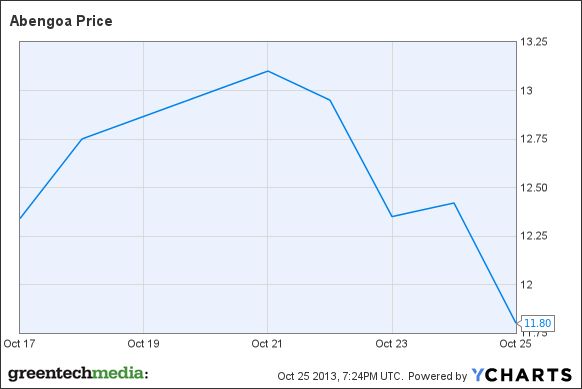Spanish technology firm Abengoa, which operates renewables projects worldwide, has listed its shares on the Nasdaq stock exchange as part of an effort to raise its profile in the U.S.
Abengoa has singled out the U.S. as a priority market, both for fundraising and for the ongoing growth of its business. “The U.S. market has become the most important market for the company,” according to chief executive Manuel Sanchez Ortega. “Today it represents the top geography in terms of revenues. One-third of our business is in the U.S.”
The company is seeking to capitalize on the reputation it has built in the country through major projects such as its 280-megawatt Solana solar thermal facility and a 25-million-gallon-per-year bioethanol facility in Hugoton, Kansas. “After more than fifteen years working in the U.S. on various projects, we have built a strong reputation and credibility through the work that we have done for our customers,” Ortega said.
“For a technology company, it is really key to perform in the most competitive market. If I’m good in Europe, I know I’m good. If I’m good in Latin America, I know I’m good. If I can be good in the U.S., it means that the company is really good. It enhances the credibility of the company,” said Ortega.
The U.S. presents a welcoming market for a number of reasons, including the size and scope of its financial sector. Part of Abengoa’s strategy in listing in the U.S. is to use the proceeds to reduce leverage and enhance its credit rating. That, along with the company’s track record, should help it to attract capital from a broader range of investors at lower cost. “Financing is a challenging activity everywhere these days,” said Ortega. “We haven’t dropped a single project because of not finding financing, but financing takes longer now than it used to.”
“People lending money today for projects are more cautious about analyzing everything in the project, and to a point, that’s good for us. Having our technology at commercial scale, having a track record of successful execution of almost $20 billion in projects over the last five years is something that financial institutions take into consideration when they consider new projects,” Ortega said.
The U.S. also has a system of incentives that supports the growth of two of Abengoa’s major U.S. products: solar thermal energy and cellulosic biofuels.
The state of California recently passed an energy storage mandate that Solana can meet without modification of the facility. “It’s great news, because the main difference of thermal solar energy is the capacity that you have to store that energy,” Ortega said. Solar thermal facilities allow for the storage of energy as heat, “so you can deliver the heat whenever you want to turn water to steam to produce electricity.”
And its Hugoton bioethanol plant, due onstream late this year or in early 2014, will be selling cellulosic biofuels into a market whose growth is all but guaranteed by rising volume requirements under the Renewable Fuel Standard, though volumes were recently amended to reflect the actual rate of development of the cellulosic biofuel industry. “The RFS is setting a clear framework that is allowing people to scale investment,” Ortega said.
“A clear and stable framework, in which people are incentivized to invest in technology and innovation, over five to ten years, is what investment requires. Because they know that there is going to be a market where they can get a return,” Ortega said.
***
Editor's note: This article is reposted in its original form from Breaking Energy. Author credit goes to Conway Irwin.




